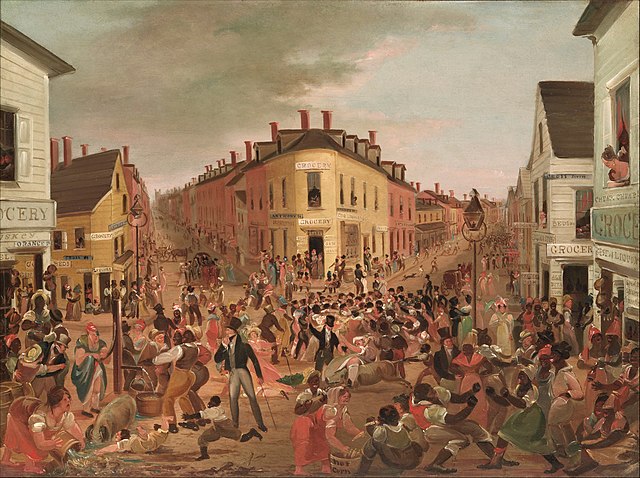“High-binders” Escape from New York
As I recounted here, the term “High-binder” or “hide-binder” appeared in the New York press in late 1806 and early 1807 after disturbances in the streets around Christmas.
At first it referred to a particular set of anti-Catholic rowdies. Soon it was being slapped on working-class Catholics instead.
In subsequent newspaper items, we can see the term spread outside of New York, though still tied to that place of origin. The 28 Apr 1813 Tickler of Philadelphia described the neighborhood of “Gotham, (New York,)” as: “Here the sailor, the ropemaker, the cookey boys and hide-binders resort to enjoy the jollifications…”
By the 1830s, “high-binder” had become the standard form, and the word was one of many labels for criminals:
In 1839, one newspaper near the Mason-Dixon Line used the term to headline an article about gamblers, both black and white (Baltimore Sun, 31 October). Another claimed that New York’s political “ultras” were adopting that label among others to seem even more scruffy and democratic (Alexandria Gazette, 5 November).
Over the following decade, Americans began using the word for corrupt politicians, not just street-level criminals. Among the rising literati, both Edgar Allan Poe and James Kirke Paulding revived the form “hide-binder” to show they were in the know. But the label was losing its power and starting to sound stale.
TOMORROW: High-binders head west.
(The picture above is George Catlin’s 1827 view of the Five Points neighborhood, now at the Met.)
At first it referred to a particular set of anti-Catholic rowdies. Soon it was being slapped on working-class Catholics instead.
In subsequent newspaper items, we can see the term spread outside of New York, though still tied to that place of origin. The 28 Apr 1813 Tickler of Philadelphia described the neighborhood of “Gotham, (New York,)” as: “Here the sailor, the ropemaker, the cookey boys and hide-binders resort to enjoy the jollifications…”
By the 1830s, “high-binder” had become the standard form, and the word was one of many labels for criminals:
- “among the thieves and high-binders of the world” (Philadelphia Daily Chronicle, 19 Apr 1832)
- “a posse of high-binders” (Newburyport Herald, 4 Aug 1835)
- “a gang of high-binders, so called” (New-York Daily Express, 6 Jul 1837)
- “the most desperate high-binders that ever graced a drunken revel upon the ‘Five Points’” (Hudson River Chronicle of Ossining, 27 Mar 1838)
- “a set of ‘high-binders’” (Baltimore Sun, 16 Sept 1839)
In 1839, one newspaper near the Mason-Dixon Line used the term to headline an article about gamblers, both black and white (Baltimore Sun, 31 October). Another claimed that New York’s political “ultras” were adopting that label among others to seem even more scruffy and democratic (Alexandria Gazette, 5 November).
Over the following decade, Americans began using the word for corrupt politicians, not just street-level criminals. Among the rising literati, both Edgar Allan Poe and James Kirke Paulding revived the form “hide-binder” to show they were in the know. But the label was losing its power and starting to sound stale.
TOMORROW: High-binders head west.
(The picture above is George Catlin’s 1827 view of the Five Points neighborhood, now at the Met.)



No comments:
Post a Comment